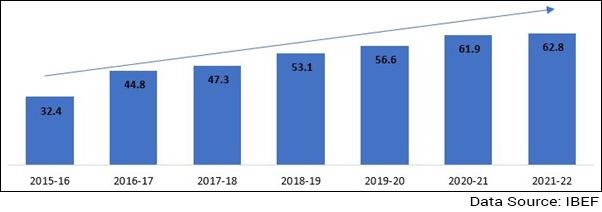Sensex Falls 500 Points As Healthcare And FMCG Stocks Under Pressure, Titan, Dr. Reddy's Lab, HUL Among Top Losers
Asian share markets are mixed today as investors eyed rising bond yields. The Nikkei is up 0.5% while the Shanghai Composite added 0.4%. The Hang Seng is down 0.2%.
Yesterday, markets followed a strong run-up with traders awaiting the release of key US and Chinese inflation data later in the week.
In US stock markets, Wall Street indices ended slightly higher on Monday with gains in Amazon and other mega-cap growth stocks offset by persistent worries over inflation.
The Dow Jones ended flat while the Nasdaq climbed 0.4%.
Back home, Indian share markets are trading with deep cuts.
Benchmark indices opened lower today following the trend on SGX Nifty live chart and tracking subdued global sentiment.
FII & DII activity is closely tracked. Net-net, FIIs turned sellers of stocks to the tune of Rs 24 bn while DIIs remained net buyers to the tune of Rs 18.4 bn.
The BSE Sensex is trading down by 497 points. Meanwhile, the NSE Nifty is trading lower by 157 points.
NTPC is among the top gainers today. Titan and Dr Reddy's Lab, on the other hand, are among the top losers today.
The BSE Mid Cap index is down 0.9% while the BSE Small Cap index is trading lower by 0.6%.
Sectoral indices are trading mixed with stocks in the FMCG sector, consumer durables sector and healthcare sector witnessing most of the selling.
Energy stocks, on the other hand, are trading in green.
Sugar stocks have started to gain traction after PM Narendra Modi announced over the weekend that India has achieved its ethanol blending target.
Shares of Oil India and MRPL hit their 52-week highs today.
With volatility easing, several Indian stocks have delivered multi-bagger returns in a quick time. But remember that many of these stocks could be 'junk stocks' and they could be fairly overvalued.
The rupee is trading at 77.70 against the US$.
Gold prices for the latest contract on MCX are trading flat at Rs 50,811 per 10 grams.
Crude oil prices inched higher today on expected demand recovery in China as it relaxed tough Covid curbs.
In news from the defence sector, defence stocks are among the top buzzing stocks today.
In a major boost to 'Aatmanirbhar Bharat', the Defence Acquisitions Council, chaired by Defence Minister Rajnath Singh, gave preliminary approval to military modernization projects costing Rs 760 bn.
This included the Navy's next-generation corvettes.
How will this help India? Well, with the approval underway, India can cut dependence on foreign imports for military equipment.
India is one of the largest defence importers in the world.
The Indian Army will procure Rough Terrain Fork Lift Trucks (RTFLTs), Bridge Laying Tanks (BLTs), Wheeled Armoured Fighting Vehicles (Wh AFVs) with Anti-Tank Guided Missiles (ATGMs), and Weapon Locating Radars (WLRs) from domestic sources.
The Indian Navy will also procure Next Generation Corvettes (NGC) at a cost of around Rs 360 bn.
Surveillance missions, escort operations, deterrence, Surface Action Group (SAG) operations, Search & Attack, and Coastal Defense will all be possible with these NGCs.
Note that since the 1970s, the Indian government has relied on imports to grow India's military strength. In this process, it spent hundreds of billions of dollars on foreign equipment.
But now, with major changes in policies, those billions have started to flow into Indian companies. It is now India's time to become self-reliant.
Note that Finance Minister Nirmala Sitharaman had announced in her Budget of 2022-23 that the defence research and development space will be opened up for the industry, start-ups and academia and 25% of the defence R&D budget has also been earmarked for this purpose.
The Indian government is likely to spend a massive US$130 bn over the next 7-8 years on the modernisation of the armed forces.
This will give a big boost to the indigenisation of defence procurement.
Increasing Budget Allocation to Defence (in US$ billion)

As can be seen from the chart above, the allocation to the defence sector is steadily rising.
We will keep you updated on the latest developments in this space. Stay tuned.
Moving on to news from the FMCG sector, FMCG companies are planning to hold on to entry-level prices and not reduce sizes of small packs despite growing input costs.
This is done as they seek to ensure sales volumes are not badly hit due to inflation.
Head at Parle Products Mayank Shah said,
There will be no price hike or grammage reduction for small packs since it will badly impact volumes, especially when there are early signs of consumers looking to downtrade.
Entry-level and small packs account for up to 55% of FMCG sales, with the exact proportion varying across product categories.
For instance, Britannia and Parle have small price packs in the range of Rs 2, Rs 5 and Rs 10, which account for 50-55% of sales.
Personal care product maker Emami's small packs make up 23-24% of sales.
Recently, Emami's vice-chairman Mohan Goenka told analysts that while there has been no significant growth in sales of low unit price packs due to inflation, the company will not increase prices or reduce grammage as there is not much scope left.
According to the latest data, India's retail inflation based on the consumer price index (CPI) jumped to an eight-year high of 7.79% in April on the back of rising input costs, resulting in price hikes.
FMCG companies have been trying to increase the entry-level price point. However, inflation has made it difficult to do so.
We will keep you updated on the latest developments in this space. Stay tuned.
Disclosure: Equitymaster Agora Research Private Limited (Research Analyst) bearing Registration No. INH000000537 (hereinafter referred as 'Equitymaster') is an independent equity research ...
more


